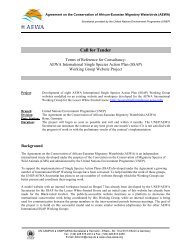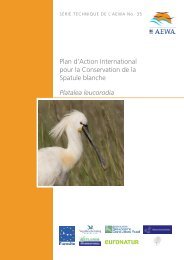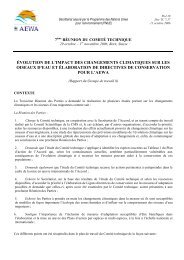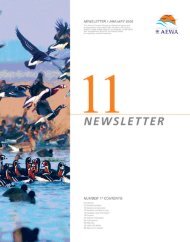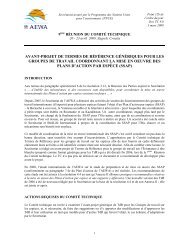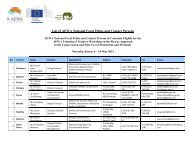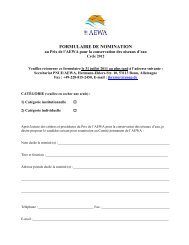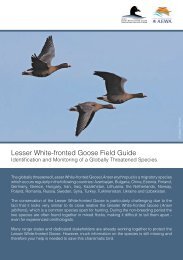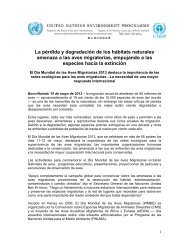Black-winged Pratincole - AEWA
Black-winged Pratincole - AEWA
Black-winged Pratincole - AEWA
You also want an ePaper? Increase the reach of your titles
YUMPU automatically turns print PDFs into web optimized ePapers that Google loves.
<strong>AEWA</strong> Technical Series No. 4<br />
6. Implementation<br />
General preconditions<br />
For the Action Plan to be successfully implemented, agreement on information exchange,<br />
communication and monitoring, clarity on necessary financial resources and a realistic time-schedule<br />
are prerequisites. It is most important that individual countries only consider measures that might<br />
affect the population after consultation with the other countries involved. The <strong>AEWA</strong> Technical<br />
Committee should play a mediating role.<br />
A special working group under the Technical Committee should be established to co-ordinate the<br />
implementation of the <strong>Black</strong>-<strong>winged</strong> <strong>Pratincole</strong> Action Plan. In this working group all <strong>Black</strong>-<strong>winged</strong><br />
<strong>Pratincole</strong> Range States and interested groups should be represented. The Range States have a<br />
responsibility in monitoring national achievements, and communicating these to the UNEP/<strong>AEWA</strong><br />
Secretariat with the request to disseminate this information to the <strong>AEWA</strong> Threatened Steppe Waders<br />
Working Group (when established) and other Range States. The population model will be a very<br />
important instrument in relation to this monitoring. This chapter will describe these essential<br />
preconditions for the implementation of the international Action Plan.<br />
Monitoring<br />
The success of this Action Plan stands or falls with the commitment of countries to monitor the<br />
population and habitats, as well as the effects of management measures on the species. Only if<br />
countries demonstrate this commitment can proper management decisions be made. All countries are<br />
requested to continue and/or initiate a regular population census and monitoring of the population<br />
(including productivity/age ratio censuses) and their habitats, with special attention to monitoring of<br />
known regular breeding, stopover and wintering sites. Collected data will be assembled within the<br />
BirdLife International World Bird Database and/or Wetlands International IWC (International<br />
Waterbird Census). The Threatened Steppe Waders Working Group under the <strong>AEWA</strong> Technical<br />
Committee will be vital in organising this overall monitoring process.<br />
Organisation<br />
In the organisation structure of the <strong>AEWA</strong>, the Agreement Secretariat plays a key role. The<br />
Agreement Secretariat co-ordinates the flow of scientific information and technical advice. It also calls<br />
meetings of the <strong>AEWA</strong> parties. The Technical Committee was established in accordance with the<br />
Agreement text and is a subsidiary body to the Meeting of the Parties. Article VII, paragraph 5 of the<br />
<strong>AEWA</strong> permits the Technical Committee to establish working groups for special purposes. This article<br />
can be used for the establishment of a Threatened Steppe Waders Working Group.<br />
Threatened Steppe Waders working group<br />
The establishment of a special Threatened Steppe Waders Working Group under the <strong>AEWA</strong> Technical<br />
Committee is suggested for implementation of this Action Plan.<br />
The working group shall, under the supervision of the Technical Committee and taking into account<br />
the role of the Agreement Secretariat, be mandated to undertake the following activities:<br />
• Co-ordinate and facilitate information exchange between Range States (and between <strong>AEWA</strong> and<br />
the Range States)<br />
• Collect country data and draft annual reports on the implementation of the Action Plan<br />
• Assist in and co-ordinate the process of National Action Plan preparation<br />
• Prepare and submit a review of the Action Plan to the triennial Range States meeting and to<br />
<strong>AEWA</strong><br />
• Monitor implementation of the Action Plan<br />
• Organise intermediate meetings with groups of Range States (training, emergency measures, etc.)<br />
32 International Single Species Action Plan for the Conservation of the <strong>Black</strong>-<strong>winged</strong> <strong>Pratincole</strong>




